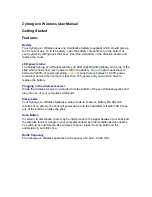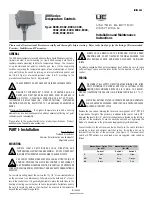
of measured
value
22
Lower limit
of
measurement
-500
~
4000
℃
The lowest measured value is SVL.
This parameter should be lowered if the ambient
temperature is too low
0
23
Control the
output switch
SSt
0
~
1
—
0: control output off (SV displays 0FF under normal
state), and only the output is off, others such as
alarm normal work;1: output open.
1
24
Alarm2
differential
gap
FH2
-500
~
4000
℃
The differential gap is 0.1 times of FH2
4
25
Temperature
of the unit
switch
Ctr
0
~
1
—
0
:
℃
;
1
:
℉
。
0
26
Overshoot
restrain
Ar2
0
~
250
—
Reserved, not used now
0
Note: if you did not press for more than 1 second after modifying the parameter, the individual
parameters may not be saved.
The change of each parameter in the list may change the control effect. Please be careful!
4.5.
Auto tuning PID parameter function
Follow 4.4. Control parameter setting operation to find the auto tuning start parameter AT,
and display the
“
AT
”
prompt on the upper row, and
“
nO
”
prompt on the lower row, indicating
that currently No limit setting or auto tuning function has been opened, Click to display the
“
YES
”
prompt below, indicating that the user is ready to start the loop auto tuning function; If
the temperature in the loop system is not allowed to exceed the set value SV too much, the next
parameter can be set as auto tuning limit ATU, which can be set as between 70 and 80% (Auto
tuning is carried out on 70 ~ 80% of the set value), Then
press more than 1 second to exit parameters Settings,
AT this point the AT indicator will flicker, indicate that the
controller in the process of auto tuning, temperature
fluctuations after two to three times to complete the whole
process of auto tuning, then the AT indicator light off, it is
concluded that a set of suitable for the loop control of P, I,
D parameter values, and according to the new P, I, D
parameters control, this P, I, D parameters will be forever in the controller.
If the auto tuning process needs to be interrupted during the setting process, the control
parameter menu needs to be re-entered, Set the auto tuning start parameter AT to nO, and then
exit the control parameter menu. AT this time, the AT indicator is off, and the controller will
control according to the original P, I ,D parameters.
4.6.
Alarm output instruction
No.
Type
Action condition
Schematic diagram (for example,
alarm 1 only)
Alarm1
Alarm2
1
alarm free
Single-digit of SA =0
。
tens digit of SA =0
。
——
2
Upper limit
deviation
alarm
Single-digit of SA =1
;
PV>SV+AH1 Alarm
;
PV
≤
SV+AH1-FH1
remove alarm
tens digit of SA =1
;
PV>SV+AH2 Alarm
;
PV
≤
SV+AH2-FH2
remove alarm
3
Minimum
deviation
alarm
Single-digit of SA =2
;
PV<SV-AL1 Alarm
;
PV
≥
SV-AL1+FH1
remove alarm
tens digit of SA =2
;
PV<SV-AL2 Alarm
;
PV
≥
SV-AL2+FH2
remove alarm
4
Upper and
lower limit
deviation
outside alarm
Single-digit of SA =3
;
PV>SV+AH1 Alarm
;
PV
≤
SV+AH1-FH1
remove alarm
;
PV<SV-AL1 Alarm
;
PV
≥
SV-AL1+FH1
remove alarm
tens digit of SA =3
;
PV>SV+AH2 Alarm
;
PV
≤
SV+AH2-FH2
remove alarm
;
PV<SV-AL2 Alarm
;
PV
≥
SV-AL2+FH2
remove alarm
5
Upper and
lower limit
deviation
within alarm
Single-digit of SA =4
;
SV-AL1<PV<SV+AH
1 Alarm
;
PV
≥
SV+AH1+FH1 or
PV
≤
SV-AL1-FH1
remove alarm
tens digit of SA =4
;
SV-AL2<PV<SV+AH
2 Alarm
;
PV
≥
SV+AH2+FH2 or
PV
≤
SV-AL2-FH2
remove alarm
6
Upper
absolute
value alarm
Single-digit of SA =5
;
PV>AH1 Alarm
;
PV
≤
AH1-FH1 remove
alarm
tens digit of SA =5
;
PV>AH2 Alarm
;
PV
≤
AH2-FH2 remove
alarm
PV
Alarm
Output
AH1
FH1
Alarm
Remove
7
Lower limit
absolute
value alarm
Single-digit of SA =6
;
PV<AL1 Alarm
;
PV
≥
AL1+FH1 remove
alarm
tens digit of SA =6
;
PV<AL2 Alarm
;
PV
≥
AL2+FH2 remove
alarm























